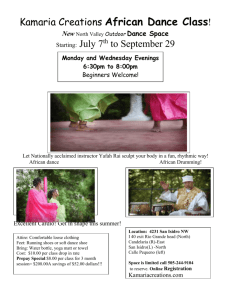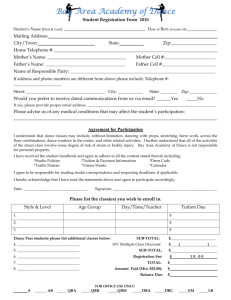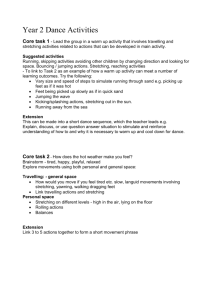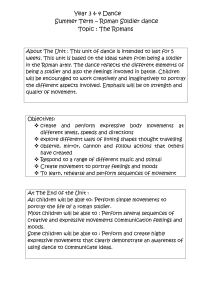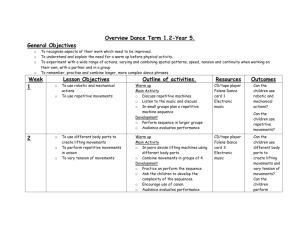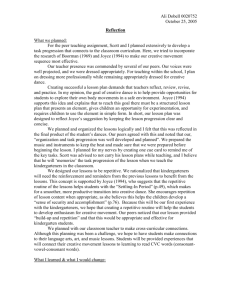Lesson: 2
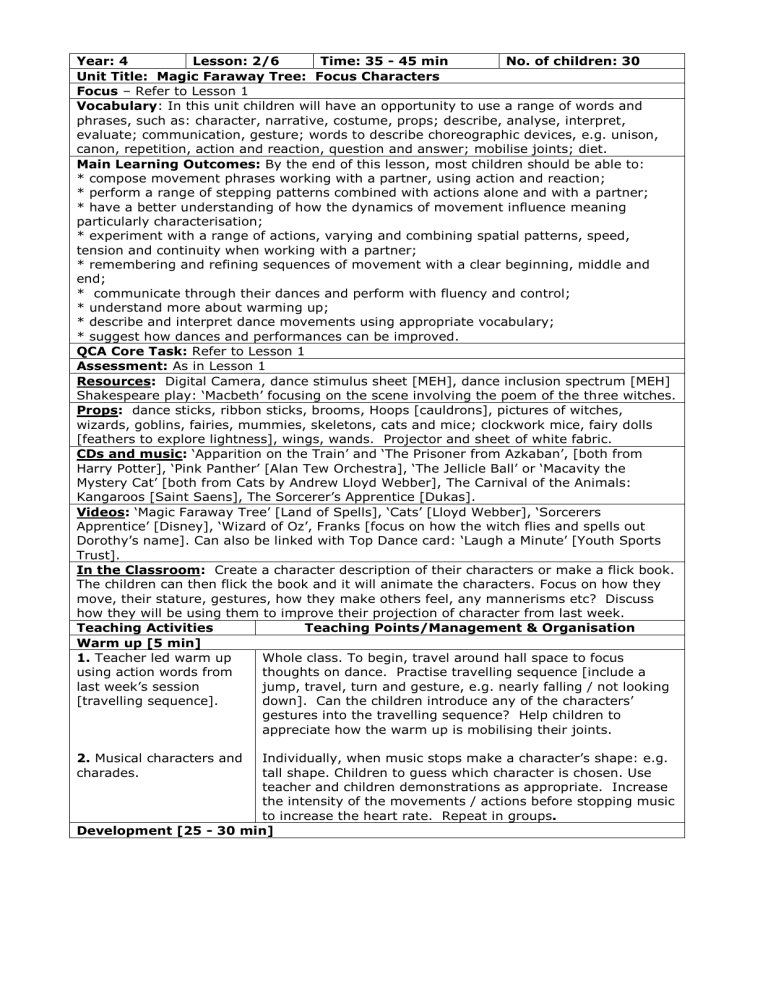
Year: 4 Lesson: 2/6 Time: 35 - 45 min
Unit Title: Magic Faraway Tree: Focus Characters
No. of children: 30
Focus – Refer to Lesson 1
Vocabulary: In this unit children will have an opportunity to use a range of words and phrases, such as: character, narrative, costume, props; describe, analyse, interpret, evaluate; communication, gesture; words to describe choreographic devices, e.g. unison, canon, repetition, action and reaction, question and answer; mobilise joints; diet.
Main Learning Outcomes: By the end of this lesson, most children should be able to:
* compose movement phrases working with a partner, using action and reaction;
* perform a range of stepping patterns combined with actions alone and with a partner;
* have a better understanding of how the dynamics of movement influence meaning particularly characterisation;
* experiment with a range of actions, varying and combining spatial patterns, speed, tension and continuity when working with a partner;
* remembering and refining sequences of movement with a clear beginning, middle and end;
* communicate through their dances and perform with fluency and control;
* understand more about warming up;
* describe and interpret dance movements using appropriate vocabulary;
* suggest how dances and performances can be improved.
QCA Core Task: Refer to Lesson 1
Assessment: As in Lesson 1
Resources: Digital Camera, dance stimulus sheet [MEH], dance inclusion spectrum [MEH]
Shakespeare play: ‘Macbeth’ focusing on the scene involving the poem of the three witches.
Props: dance sticks, ribbon sticks, brooms, Hoops [cauldrons], pictures of witches, wizards, goblins, fairies, mummies, skeletons, cats and mice; clockwork mice, fairy dolls
[feathers to explore lightness], wings, wands. Projector and sheet of white fabric.
CDs and music: ‘Apparition on the Train’ and ‘The Prisoner from Azkaban’, [both from
Harry Potter], ‘Pink Panther’ [Alan Tew Orchestra], ‘The Jellicle Ball’ or ‘Macavity the
Mystery Cat’ [both from Cats by Andrew Lloyd Webber], The Carnival of the Animals:
Kangaroos [Saint Saens], The Sorcerer’s Apprentice [Dukas].
Videos: ‘Magic Faraway Tree’ [Land of Spells], ‘Cats’ [Lloyd Webber], ‘Sorcerers
Apprentice’ [Disney], ‘Wizard of Oz’, Franks [focus on how the witch flies and spells out
Dorothy’s name]. Can also be linked with Top Dance card: ‘Laugh a Minute’ [Youth Sports
Trust].
In the Classroom: Create a character description of their characters or make a flick book.
The children can then flick the book and it will animate the characters. Focus on how they move, their stature, gestures, how they make others feel, any mannerisms etc? Discuss how they will be using them to improve their projection of character from last week.
Teaching Activities
Warm up [5 min]
Teaching Points/Management & Organisation
1. Teacher led warm up using action words from last week’s session
[travelling sequence].
Whole class. To begin, travel around hall space to focus thoughts on dance. Practise travelling sequence [include a jump, travel, turn and gesture, e.g. nearly falling / not looking down]. Can the children introduce any of the characters’ gestures into the travelling sequence? Help children to appreciate how the warm up is mobilising their joints.
2. Musical characters and charades.
Individually, when music stops make a character’s shape: e.g. tall shape. Children to guess which character is chosen. Use teacher and children demonstrations as appropriate. Increase the intensity of the movements / actions before stopping music to increase the heart rate. Repeat in groups.
Development [25 - 30 min]
3. Use the character descriptions and pictures to further explore movement.
4. Develop and practise the phrase making the movements more flowing
[still finishing with the character pose].
5. Explore different group relationships, e.g. one behind the other, side-byside and mirroring.
6. Progress to including changes of direction, and use of canon.
In groups. Ask children to create a logical movement phrase, including travelling and turning. Encourage use of space, through exploring different pathways, and changing levels, shape and speed.
In groups. Use demonstrations for positive role models and to generate new ideas. Encourage children to use contrasting movements. Also encourage exaggerated movements to convey clear meaning. Perform the phrase in unison, copying and mirroring the still body shapes. Introduce the music.
In groups. Encourage children to include clear variations in body shapes and levels and to show awareness of each other and their space.
7. Practise and refine.
8. Demonstrations. Using projector and sheets of white fabric, children to perform behind sheet.
In groups. Ask children how this affects the movement?
Encourage suggestions to how motifs can be improved to include these and to communicate the dance idea more clearly.
Share with another group. Groups given evaluation sheets to complete, e.g. what direction did the group move? What action did they do in canon? Was it effective? What can be improved?
In groups. Encourage children to talk about how successful they think different motifs are in expressing their dance idea.
In groups. Insist on clarity of shape. Why are exaggerated movements essential? What did the children like about the performances? Video for evaluation purposes and to support next sessions learning, or take still images of groups in various poses as a support.
Cool down [3 –5 min]
9. As a class watch parts of the ‘Sorcerers
Apprentice’.
Whole class to share ideas. For example, how does it convey meaning? What will you do to convey meaning next time to make it an even better dance? How important is the music?
Lesson Evaluation
[Written by Merie Eglesfield-Hope 2005]





